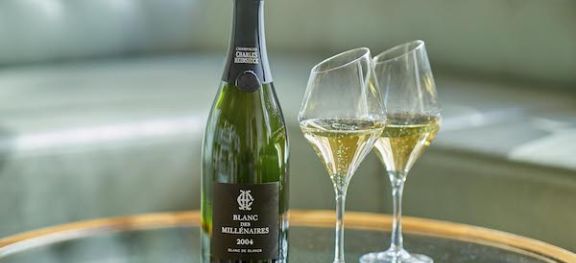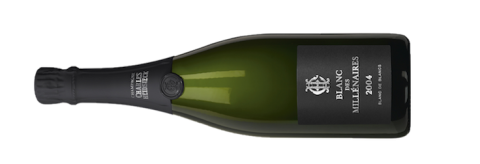Charles Heidsieck, Blanc des Millénaires 2004 Champagne

A truly luxurious champagne you may not have considered.
From €105, HK$930, 145 Swiss francs, $149.99, £119.95, 1,495 Norwegian kroner, AU$379, 21,900 Japanese yen, NZ$325, 6,750 Taiwanese new dollars, 1,699 Danish kroner
Treat yourself to a really special bottle to see in the next decade, or to share with some very special people over the holiday season. This wine was my favourite in a recent blind comparison of 2002 and 2004 prestige champagnes on which we reported last week on Purple Pages.
Yet it was far from the most expensive. It easily withstood comparison with the likes of Krug, Dom Pérignon, Cristal, Comtes de Champagne, Bolllinger RD, Cuvée Sir Winston Churchill and Dom Ruinart that sell at prices up to £375 a bottle.
I loved the sheer confidence, appeal and completeness of this all-Chardonnay wine, always based on ingredients from four of the finest grand cru villages on the Côte des Blancs together with some wine from premier cru Vertus. According to Cyril Brun, the cellarmaster at Charles Heidsieck since 2015, of all the wines in his stable (including a range of still Coteaux Champenois nowadays), this is the easiest to make. ‘The personality of each village is quite different but they make a great blend.’
In this 2004, a vintage that showed very well when compared blind with the much-lauded 2002s of the same wine, the blend is made up of similar quantities of each ingredient, from Cramant for stony limestone character, exotic and almost tropical Avize, full-bodied and structured Oger, smoky and stately Mesnil-sur-Oger and sharp, floral Vertus. That’s the theory anyway. The result is just what you want of a top-quality champagne. Admittedly, it’s very classic. Complex and minutely woven, the elements having had more than 11 years on lees in bottle to knit together, this is creamy-textured and just ridiculously easy to enjoy. As Brun observes, it’s made to a standard six bars of pressure but often tastes rather less fizzy than that, perhaps because it’s so dense.
In the summer of 2017 I had the pleasure of tasting every vintage of this wine, Charles Heidsieck’s top-of-the-range bottling launched with the 1983 vintage. (The 1981 Blanc de Blancs had been a prototype.) The 1983 – the regular bottling disgorged in 1991 – was still entrancing. When I first tasted this 2004 back in June 2017, it tasted considerably more youthful. I wrote: ‘Strongly green tone. Even slightly oily on the nose – dramatic. Real bite and class. Great balance. Tiny bead. Super-elegant but not wimpy. Makes you salivate. Slightly salty note on the end. Confident, persistent finish.’
Disgorged in November 2016 and launched about a year later, the 2004 has a dosage of 9 g/l, about the same as Cristal, Comtes and Churchill. During my 2017 visit Brun explained that when he arrived he had experimented with lower dosages for the range, but felt that 9, or even 10, suited the Charles Heidsieck style best. The wines that go into Blanc des Millénaires always go through full malolactic conversion, which perhaps adds to its creaminess. But it certainly doesn’t taste at all sweet. Presumably the top-quality sources of Chardonnay play a part in this.
After trialling DIAM’s sparkling wine stopper Mytik on a third of his wines, Brun has now adopted this ‘technological cork’ for all Charles Heidsieck wines. Ardent champagne taster, and retailer, Nick Baker of The Finest Bubble claims it has a slight preservative character whereby champagnes open up slightly later than those under natural cork. Certainly when I tasted the 2004 recently it seemed to have come on in leaps and bounds and be already providing massive pleasure with great texture and persistence – though on the basis of the 1983, I would expect it to have many, many more years of life in it. Although yields were generous, 2004 is clearly a very successful vintage for top-quality champagne, especially on the Côte des Blancs. The all-Chardonnay wines in our recent blind tasting demonstrated this by showing particularly well.
Blanc des Millénaires (‘white of millennia’, to translate literally – not ‘millionaire’s white’) has been made relatively rarely. The only other vintages have been 1985, 1990 and 1995. Yes, 2004 is the follow-on vintage from 1995! The story goes that Daniel Thibault, Charles Heidsieck’s talented cellarmaster from 1976, who died far too young in 2002, fell in love with the 1995 vintage. The result was that he went ahead and made 10 times more than was suggested by the then president of Charles Heidsieck. He justified this with the observation that presidents change far more frequently than cellarmasters, and indeed the magnificent 1995 Blanc des Millénaires seemed to be in circulation for ever and a day, presumably being disgorged several times.
Charles Heidsieck has had its ups and downs to say the least. Between 1985 and 2011 it was owned, along with Piper-Heidsieck (with which it shares production facilities outside Reims), by the Rémy Cointreau group. For much of that time, they also owned Krug and ‘Charles’ was decidedly overlooked in favour of this more famous champagne house and Rémy Martin’s portfolio of spirits. But in 2011, the head of the private French EPI Group picked up the two Heidsieck champagne houses, presumably at a bargain price. (Neither are big vineyard owners.)
A week tomorrow I will be telling the story of how the reputation of Charles Heidsieck has been revived.
When I tasted the full range of Blanc des Millénaires back in 2017 we had a duff bottle of 1990 but I gave the 1983 and 1985 a score of 19 and the embryonic 2004 a score of 18.5+. In this recent tasting the 2004 was a clear 19. The 2004, incidentally, will have been made by Thibault’s equally revered successor Régis Camus.
The wine is very widely available so is clearly made in a fair old quantity. (I sense that the current owner has fairly loose purse strings when there is a need to purchase top-quality ingredients.) The 2004 is in virtually every European country, including many eastern European ones and all Scandinavian ones except Sweden, and is well distributed in the US, Japan, Australia, New Zealand and Taiwan. I didn’t spot any Canadian listing on Wine-Searcher, however. The Canadians are missing out!
In the UK there are many ‘in bond’ offers but the lowest price duty paid, if Wine-Searcher.com is to be believed, is from Dunnell’s of Jersey. The Champagne Company and ChampagneDirect.co.uk list prices just over £140 a bottle including tax. The Wine Society price is £145 and some of the Laithwaite’s direct sales operations list it at £150. It’s also available at many more independent retailers. Retail prices in the US vary much, much more: from $149 to $369 a bottle. Buyer beware.
Become a member to view this article and thousands more!
- 15,414 featured articles
- 274,282 wine reviews
- Maps from The World Atlas of Wine, 8th edition (RRP £50)
- The Oxford Companion to Wine, 5th edition (RRP £50)
- Members’ forum
- 15,414 featured articles
- 274,282 wine reviews
- Maps from The World Atlas of Wine, 8th edition (RRP £50)
- The Oxford Companion to Wine, 5th edition (RRP £50)
- Members’ forum
- Commercial use of our Tasting Notes

